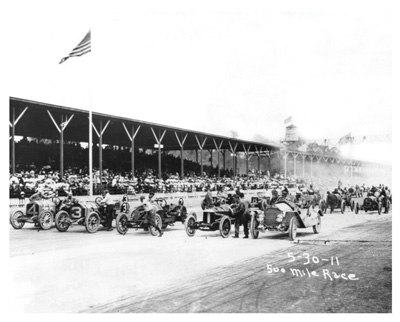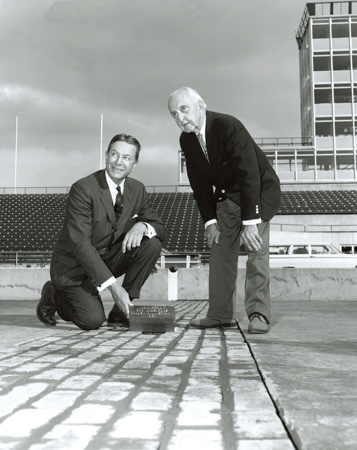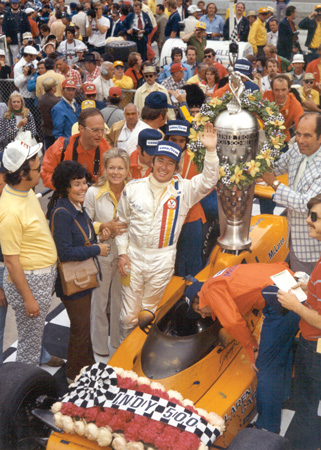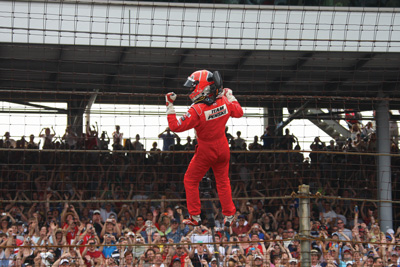1908
■ Four partners (Carl G. Fisher, James Allison, Arthur Newby and Frank Wheeler) pay $72,000 for 328 acres of farmland 5 miles northwest of downtown Indianapolis that would be the future home of Indianapolis Motor Speedway.
1909
■ Construction of the speedway begins in March.
■ In September, $400,000 is raised to resurface the track with 3.2 million paving bricks after the original surface disintegrates, contributing to multiple crashes and five fatalities during early races.
1911
 |
| Photo by: Indianapolis Motor Speedway |
■ The first International Sweepstakes (now the Indianapolis 500) takes place. The winner receives $14,250.
1917
■ America enters World War I and racing is suspended until 1919. The track becomes an aviation-repair facility and airport. Also, the race would not be run from 1942 to 1945 during World War II.
1919
■ The race returns after WWI as the Liberty Sweepstakes. From 1920 to 1980, the race officially reverts back to the International Sweepstakes.
1922
■ The first radio coverage of the race is provided as stations WOH and WLK broadcast descriptions of the race to a small number of households in the Indianapolis area.
1927
■ Former driver and World War I veteran Eddie Rickenbacker buys the speedway for $750,000.
1928
■ NBC radio airs the final hour of the race on affiliates nationwide with Graham McNamee as anchor.
 |
| Photo by: Indianapolis Motor Speedway |
1936
■ The Borg-Warner Trophy is awarded for the first time to the race winner. Borg-Warner Automotive commissioned Robert J. Hill to design the trophy at a cost of $10,000.
■ Louis Meyer becomes the first driver to drink milk in victory lane and also is the first driver to receive the pace car (a Packard convertible) for winning. The custom of drinking a bottle of milk in victory lane would be revived in 1956 and has been a tradition ever since.
1945
■ Tony Hulman buys the track for $750,000 and revives the race, which had ceased during WWII.
1946
■ American operatic tenor and car enthusiast James Melton starts the practice of singing “Back Home Again in Indiana” with the Purdue marching band. This tradition has continued through the years.
1949
■ Local television station WFMB airs the race for the first time.
1952
■ The Indianapolis Motor Speedway Radio Network launches and airs portions of the race. The network has broadcast the race in its entirety since 1953.
1961
 |
| Photo by: Indianapolis Motor Speedway |
■ ABC’s Wide World of Sports first broadcasts time trials on tape delay. They have since aired on ABC, ESPN, ESPN2 and Versus (now NBCSN).
■ The remaining bricks on the front straightaway are covered with asphalt, except for a 36-inch strip at the start/finish line, now known as the Yard of Bricks.
1964
■ The race is shown on closed-circuit television in theaters and venues across the nation and would be shown in that format until 1970.
1965
■ ABC debuts its hourlong edited race coverage on Wide World of Sports, on the Saturday following Monday’s race.
1971
■ ABC shows same-day, tape-delayed footage in prime time for the first time. This format would continue through 1985.
1972
■ Roger Penske and Team Penske score the first of a record 16 Indianapolis 500 victories.
 |
Johnny Rutherford celebrates in 1974.
Photo by: Indianapolis Motor Speedway |
1974
■ The speedway alters its no-Sunday racing policy, a tradition dating to 1911, and the race is run for the first time on a Sunday.
1977
■ Janet Guthrie becomes the first woman to qualify for the race.
1981
■ The name “65th Indianapolis 500-Mile Race” is officially adopted and the event has since been known as the Indianapolis 500. That particular race was decided by an appeals board 138 days after the race ended, with Bobby Unser being declared the winner.
1986
■ ABC Sports moves its race coverage from tape delay to a live broadcast, and the entire race is televised on network television for the first time. The local Indianapolis affiliate is required to black out the live broadcast and carry it on tape delay in prime time, a practice that continues today.
1989
■ Winner Emerson Fittipaldi receives a record first-place prize of more than $1 million from a record purse of $5.7 million.
1991
 |
| Photo by: Indianapolis Motor Speedway |
■ Willy T. Ribbs is the first African-American to qualify for the race.
1994
■ John Andretti becomes the first driver to attempt to drive in both the Indianapolis 500 and NASCAR’S Coca-Cola 600 in the same day. Drivers Robby Gordon, Tony Stewart and Kurt Busch would later attempt the feat, with Stewart being the only driver to complete the full race distance in both events on the same day.
■ Indianapolis Motor Speedway President Tony George announces plans to leave the CART open-wheel series and form the Indy Racing League, which ran its first race in 1996, splitting the sport.
2001
■ Several top CART teams return to Indy for the first time since 1995, despite the ongoing open-wheel split. The sport would reunify in 2008.
 |
Race winner Helio Castroneves climbs the fence in 2009.
Photo by: Indianapolis Motor Speedway |
2009
■ Indianapolis Motor Speedway begins a three-year-long “Centennial Era” to celebrate the 100th anniversary of the opening of the track (1909), and the 100th anniversary of the first Indy 500 (1911).
2011
■ ABC extends its exclusive contract to carry the Indianapolis 500 through 2018.
2016
■ The Indianapolis 500 for the first time will have a presenting sponsor, PennGrade Motor Oil. The three-year deal is worth approximately $5 million.
Source: SportsBusiness Journal research









